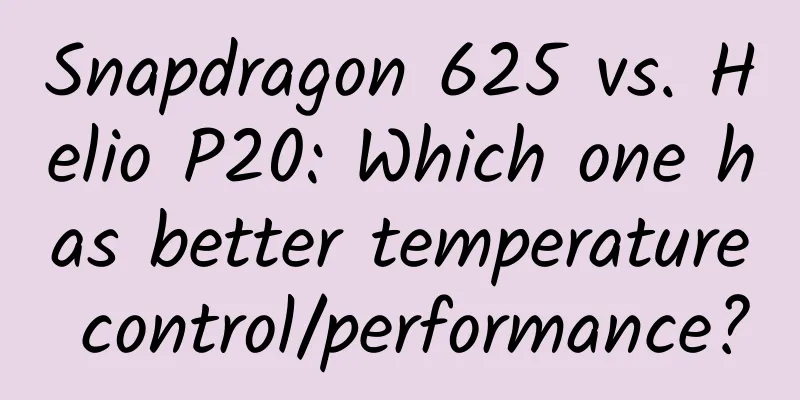Snapdragon 625 vs. Helio P20: Which one has better temperature control/performance?

|
In the mid-range mobile phone market in 2016, models equipped with Qualcomm Snapdragon 625 were highly praised in terms of battery life and heat generation. The reason for this is that the use of the same 14nm process technology as the flagship Snapdragon 820 is the biggest driving force. The process technology may be one of the most critical factors in determining the performance and heat generation of a chip. By the end of the year, the mid-range market finally had another chip that could compete with the Snapdragon 625: MediaTek Helio P20, which uses the same top-level 16nm process technology and 8-core A53 architecture as the Snapdragon 625. So which of these two chips is better? I happened to have a Redmi 4 with Snapdragon 625 and a Meizu X with Helio P20, so I made a comparison. First, let's compare the parameters of the two chips. In terms of CPU, both use the 8-core A53 architecture. The 8 cores of Snapdragon 625 are all clocked at 2.0GHz, while Helio P20 (Meizu X) uses a 4-high-frequency plus 4-low-frequency design, with a maximum clock speed of 2.35GHz. In terms of GPU, both have average parameters, and the biggest highlight is the process technology. Both use the current top 14/16nm process. After talking about the parameters, let's take a look at the running points. Although the running point software has its own limitations, it is still the most valuable reference factor for measuring the quality of a chip. The author selected Antutu and Geekbench as the performance measurement standards. Let's take a look at the running point performance of the two chips.Snapdragon 625 on the left and Helio P20 on the right. Antutu's running score shows that the total score of Snapdragon 625 is 61916 points, while the total score of Helio P20 is 65766 points. Helio P20 is slightly better. In terms of each sub-item, the two chips have their own advantages and disadvantages. The difference between the two is most obvious in UX performance, and the differences in other sub-items are not very large. The following is a test of Geekbench 4, which tests the CPU single-core/multi-core performance. The left side of the figure below is Snapdragon 625 and the right side is Helio P20. In terms of CPU single-thread, both are A53 architectures. Although the frequency is different, the difference in single-thread is not much, 833 VS 854 points. In terms of multi-thread, the gap between the two is widened. The multi-core score of Snapdragon 625 is 2814 points, while Helio P20 is more than 1,000 points higher, reaching 3897 points. After talking about the running score, let's take a look at the actual daily performance. After all, the running score software tests the peak performance of a chip, and it is impossible to maintain peak performance in daily use. ▲Daily core scheduling of Helio P20 ▲Daily core scheduling of Snapdragon 625 In daily use, the core scheduling of Snapdragon 625 is more active, basically all 8 cores are fully open. When used lightly, the core frequency is low, and the 8 cores run at full frequency as soon as the application is opened. The core scheduling of Helio P20 is not very active. Under normal circumstances, only about 3 cores are opened, and they run at full frequency in the interval between running points and when the software is opened. Finally, let's take a look at the heat. In fact, the most commendable thing about Snapdragon 625 and Helio P20 is heat control. Thanks to the most advanced 14/16nm process, the heat control of these two chips may be the best among all Android mobile phone chips. On the one hand, it is the top process technology. On the other hand, because these two chips are positioned in the mid-range, the CPU and GPU parameters are not strong enough. Compared with the flagship chip, the performance is sacrificed but the power consumption is low. When running the AnTuTu running test, the heat of the two chips is roughly the same. The highest temperature on the front of the fuselage is 34.5℃, and the highest temperature on the back is 31.9℃. The fuselage feels only warm to the touch, and the heat control is excellent. Summary: From the above, we can see that the overall performance difference between Snapdragon 625 and Helio P20 is not particularly large. The only big difference is that Helio P20's CPU multi-threading performance is outstanding, but in daily use, you can't feel much difference between the two. The most praised point of these two chips is power consumption/heat control, especially the heat control performance is extremely good. Snapdragon 625 and Helio P20 will definitely become the best CPU of the generation. As a winner of Toutiao's Qingyun Plan and Baijiahao's Bai+ Plan, the 2019 Baidu Digital Author of the Year, the Baijiahao's Most Popular Author in the Technology Field, the 2019 Sogou Technology and Culture Author, and the 2021 Baijiahao Quarterly Influential Creator, he has won many awards, including the 2013 Sohu Best Industry Media Person, the 2015 China New Media Entrepreneurship Competition Beijing Third Place, the 2015 Guangmang Experience Award, the 2015 China New Media Entrepreneurship Competition Finals Third Place, and the 2018 Baidu Dynamic Annual Powerful Celebrity. |
<<: Accenture: Reshaping business operations with the next generation of artificial intelligence
>>: Geely Star is willing to invade BYD's heartland. Can the high-end version beat BYD Dolphin?
Recommend
Zuckerberg's New Year's resolution: Let artificial intelligence control the home environment
[[161183]] Facebook CEO Mark Zuckerberg wrote on ...
18 APP promotion experiences, each one is worth money! !
Today I’d like to share some tips on APP promotio...
China Association of Automobile Manufacturers: 2021 China Automobile Industry Economic Operation Report
In 2021, automobile production and sales reached ...
How can I increase the number of followers by creating a museum account on Douyin?
The author of this article breaks down the operat...
Declaring war on products: Android UI Design from the perspective of developers
After half a month of preparation, I have been th...
What should I do if I experience roller coaster-like dizziness?
Author: Xiao Lin China Rehabilitation Research Ce...
Use day cream during the day and night cream at night? Can I use whatever I want?
Reviewer: Yang Rongya, Chief Physician, Seventh M...
16 negotiations for 2 seconds! That night 25 years ago...
2 seconds, 23 seconds, 12 seconds There is a stor...
Apple quickly withdraws iOS 14.3 after releasing it: Reason unknown
[[352022]] Apple did the same thing again. Wasn’t...
Latest research! New artificial intelligence model can predict the effect of brain glioma treatment
Gliomas are tumors that originate from brain glia...
If someone says you have a "dead fish face", it's probably not an insult...
From a broader perspective, the evolution of fish...
Wild boars are rampant in many places, and dealing with conflicts between humans and animals requires scientific approach
Recently, wild boars have appeared in many places...
2021 New Product Marketing Methodology
For marketers, launching new products is a period...
Let’s take a look at the selling methods of the hot-selling brands on Double 11, which are full of tricks!
The annual Double 11 global shopping carnival is ...









